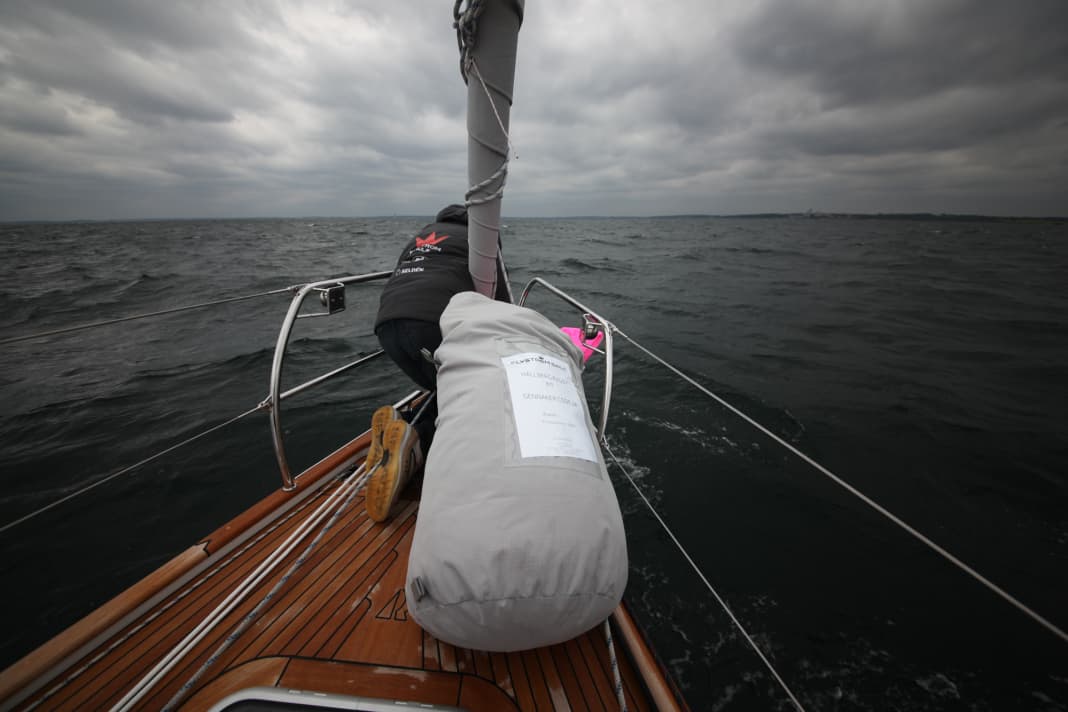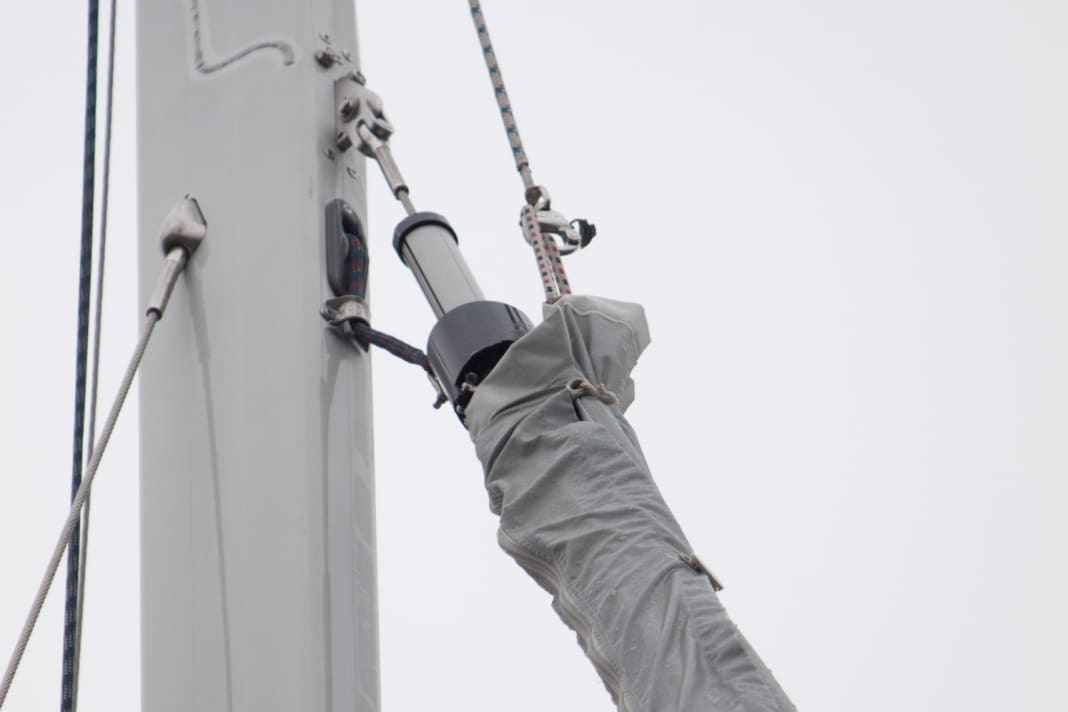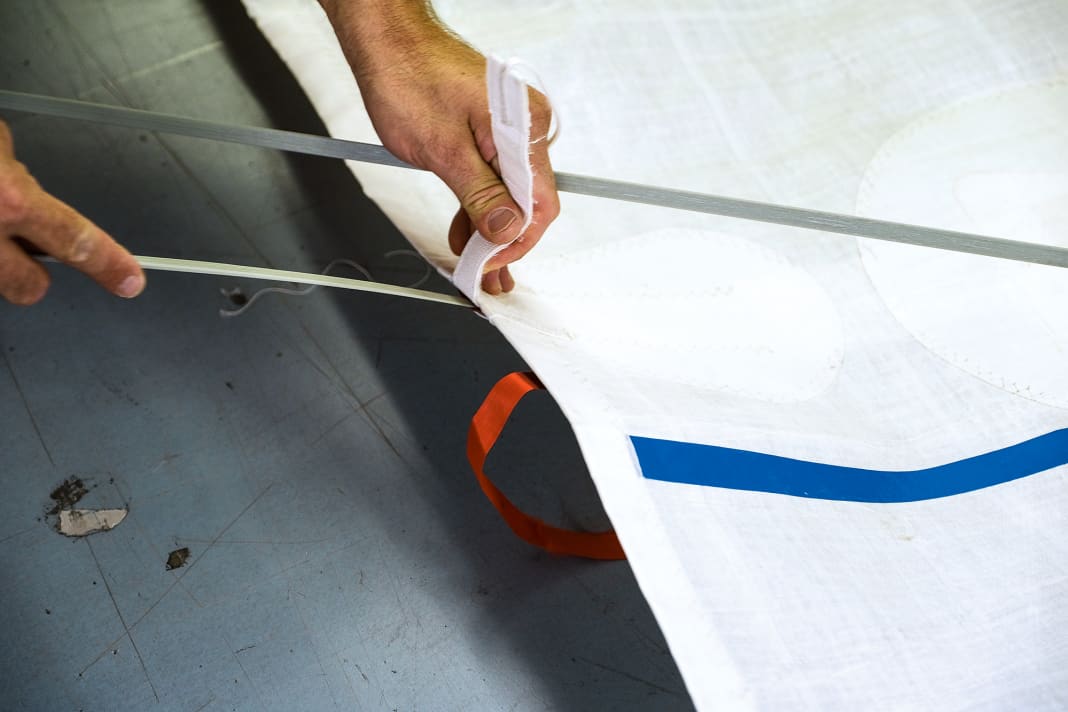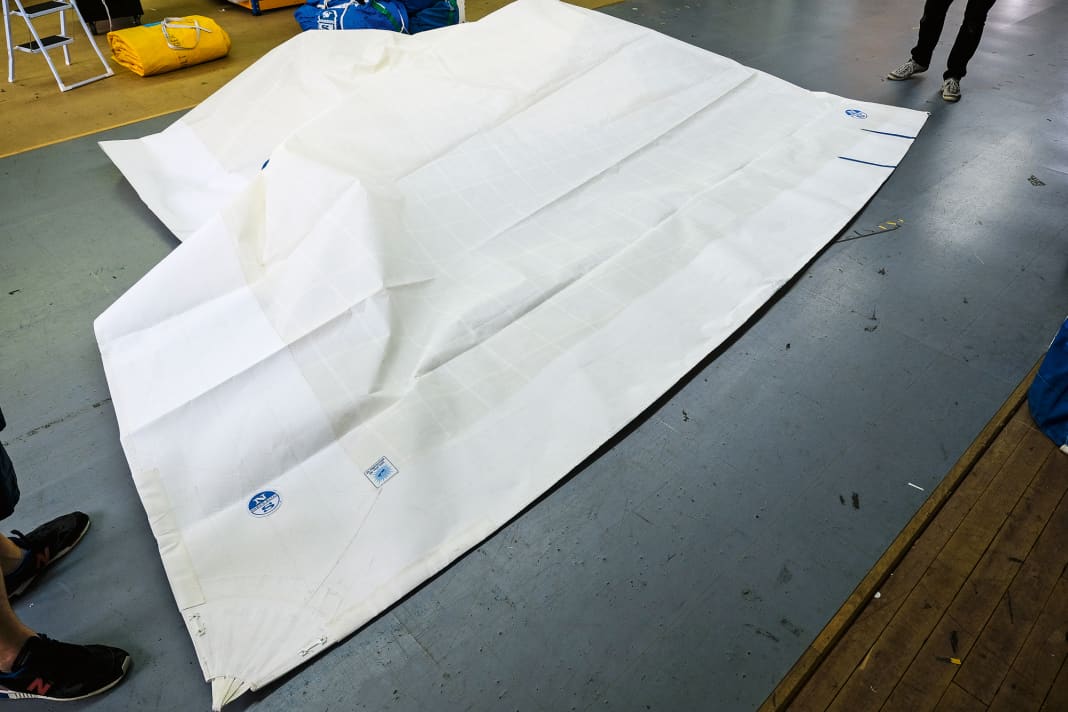Stowing sails: Well bagged - that's what matters with sail bags






This article is part of a sailing special. The contents:
Sail bags can be more than just a simple nylon square with straps. At the latest when a heavy main has to be balanced on or off board, for example, those with several sturdy handles that can be moved with two or even four hands have an advantage. Particularly heavy sails require a solid central suspension point for the halyard crane.
"The size of the bags must match the sail; neither too big nor too small is sensible," recommends Jens Nickel from the Stade sail workshop. "They should also always have gauze at the bottom to get the moisture away from the sail." However, this allows the moisture to get into the boat, a problem that regatta participants in particular have to live with due to the sail changes. Or the cloths get wet when they are stored on deck. As is so often the case on board, it is important to find the right compromise.
Long bags for long slats
Anyone who goes sailing with a change of cloths will be pleased to have clearly labelled bags. But be careful here too: "Coloured bags can rub off," warns Marco Haase from Haase Segel in Travemünde. Alternatively, imprints, tags or sewn-on coloured spinnaker bungees can help.
In fully battened mainsails, the battens usually remain in the pockets, in some systems anyway. The matching long bags are often supplied - either in the simplest form as a tube into which the sail has to be rolled from the head. Or as a long bag with a zip. The advantage of these bags, even if the sails could be folded: no creases.
Quick setting and recovery of spinnaker and co.
Code zero, gennaker or spinnaker are set and recovered at sea and in windy conditions. With the classic spinnaker bag with ring, the cloth is simply stuffed in from above. A cube-shaped bag with four carabiners is useful for setting from a hatch or companionway. Sören Hansen from Elvstrøm in Aabenraa, Denmark, explains the advantage over the classic round models: "Even on cruising yachts, a small ropeway can be fitted inside, i.e. two lines that run port and starboard under the cabin ceiling from the cabin bulkhead next to the companionway to the main bulkhead or mast." The spinnaker bag can be suspended from this below deck and, if necessary, pulled aft for setting, even several in a row, so that the next size of spinnaker is ready and waiting.
"Some regatta sailors set and retrieve without a sail bag from the forward hatch, but then it gets wet where the owner's locker is often located, and that has to be accepted by the ship's command," says Sven Krause from Quantum Sails in Flensburg, explaining current practice on the course. To do this, the hatch must open aft, as is now common practice on many yachts anyway.
"Spinnakers from around 250 square metres are therefore often made with a sewn-in zip, where the sliders are pulled out over the end," says Marco Haase, describing a modern solution. They then open in a similar way to the fasteners on many automatic lifejackets. Household rubber bands, as was the practice decades ago, are now outdated because they end up in the water.
Long bags for headsails
Regatta headsail bags are slightly longer than the foot. Only the tack, halyard and sheet come out of their own openings. The zip is then pulled open for setting, some open with a slight pull. "We have developed regatta bags that are significantly lighter than conventional models and don't absorb any water," says Stefan Voss from UK Sailmakers in Flensburg, explaining the high-end weight saving. This is because in most classes it is now forbidden to use "stacking" - the time-consuming but effective re-stowing of heavy sail bags in favour of optimum fore and aft trim.
Such deck bags, which originate from racing, are also practical for cruising sailors. On the one hand, the long but narrow sausages fit well through the fore hatch; they are particularly interesting for code zero or gennakers. The stiff anti-torsion cable has to be included in the bag, which is why it is wider. Some bags extend from the forestay to the jib, with four back and forth turns of the unfurled sail it is stowed in the bag, which then only needs to be closed and tied. Shorter models require several zigzag layers of the sail, or it is twisted in a circle like a cable luff.
Stow sails: Special requests and solutions
Traditional bags are mainly used for storm sails. Despite the fabric weight of usually 400 grams per square metre, the sails and therefore their bags are manageable and generally easy to stow below deck.
All experts agree that sails, even in pack sacks, should be kept in the shade below deck as often as possible. If, for space reasons, sails are to be taken on a trip as deck cargo, some sailmakers, saddlers or tarpaulin makers supply deck bags made of thick cloth. These then lie on deck - in the way and often in the wet. This can be remedied by a specially made bag made of tarpaulin that runs from the pulpit to the shroud and hangs between the railing wires. "Blue water sailors often want customised products. Almost all ideas can be realised in contact with the sailmaker," says Jan Heinritz from Jan Segel in Heiligenhafen, describing the service offered by established companies.
"One customer stowed his special sail on the cabin roof under the main boom. He was given a watertight cover for this, which is lashed to the rigging," Marco Haase reports on customised sewing requests. "Another had come up with an airtight bag with a drysuit zip, which hangs under the tree. When you sit on it, the excess air escapes through a pressure relief valve," says Haase, citing examples of customisable solutions. For a Stagreiter foresail, he sewed a kind of boom dress that is fastened with toggles over the sausage lying on the railing. It may all look unusual, but it also shows that many things are possible to make storage and handling more convenient.
Sail tarpaulin: alternative for the jib






If the genoa or jib are not stowed away after sailing but rolled around the forestay, they need to be protected from UV radiation, bird chaff and accidental unrolling. This is most effectively achieved with a tubular tarpaulin, which is pulled over the sail using a spinnaker halyard. However, if this does not sit tightly on the sail furling, it will flap in the wind and can quickly break.
The upper part in particular must be wide enough to be pulled over the furled clew. At the top, however, the sail roll becomes thinner as there are fewer layers on top of each other. The furling tube must therefore be gathered together. To do this, the furling lines or reefing lines are used like the laces of a shoe. The necessary deflections should be easy to move.
From a luff length of 10 to 14 metres, this tensioning system is divided into two parts so that the entire tarpaulin can be tensioned evenly. Co-Segel also offers a system with customisable deflections. However, these would have to be changed when switching from the large genoa to the small working jib, for example.
When sailing, the cover goes into the back box. A large sewn-on pocket is then helpful so that the tarpaulin can be stowed inside itself to save space. As an alternative to the tarpaulin, the UV protection can be sewn onto the leech and foot leech. The protective Dacron fabric is attached as a strip about 20 centimetres wide. This provides continuous protection as soon as the sail is furled. What's more, there is now even transparent UV protection that can be painted on.
Storing sails correctly in winter






When the boats come out of the water in autumn, storage rooms and attics fill up again with cushions, equipment and, of course, sails. But what's the best way to store them? We asked North Sails in Hamburg's Speicherstadt warehouse district.
It is best to simply roll up the cloth lengthways from the foot. However, this long sail sausage can neither be transported in the car nor stored to save space. So it has to be folded.
The following applies: do not always lay the sail in the same folds, as the coating on the fabric wears off more quickly at these points and the material suffers. As the sail on the mast always creases at the mast slides, it is better to fold it in between for the winter and prevent the windows from creasing if possible. It is also important to ensure that the sails are dry and the battens and leech lines are relaxed before folding.






